ISSN ONLINE(2319-8753)PRINT(2347-6710)
ISSN ONLINE(2319-8753)PRINT(2347-6710)
Sivaraman R1, Roseenid Teresa A2, Siddanth S1
|
| Related article at Pubmed, Scholar Google |
Visit for more related articles at International Journal of Innovative Research in Science, Engineering and Technology
The Elastomeric rubber is a good energy absorbing device with spring back effect. The effectiveness of any form of rubber depends on its strength and stiffness which cannot be varied beyond a certain limit by using chemical additives alone. So, the elastomeric rubber has to be reinforced by adding a material that is normally stronger and stiffer than rubber. In this paper, the usual problem of vulcanization of rubber was overcome by selecting carbon fibers as the filler material. The unidirectional property of carbon fibers gives it the ability to be oriented in any desired direction, thus imparting required properties. The material was modeled as a composite beam structure initially using the ANSYS software and dynamic analysis was performed to find out the fundamental mode of vibration. A Test specimen was then fabricated according to ASTM standards and experimental investigations were carried out. Mechanical properties of the material such as tensile strength, compression strength, flexure strength and impact strength were obtained from the experimental investigation. The test results of the carbon fiber laminated elastomeric rubber were then compared with ordinary elastomeric rubber with usual additives and it was found to be superior in all aspects.
Keywords |
| Elastomeric rubber laminates, Unidirectional Carbon fiber composites, Fabrication of Carbon fiber laminates, Modes of vibration of rubber composite, Mechanical properties of rubber composite. |
INTRODUCTION |
| Rubber is an engineering material that finds use in most of the products that we use every day. To name a few, rubber is profoundly used as door and window profiles, hoses, belts, matting, flooring and dampeners (anti-vibration mounts) in the automotive industry and as structural material in buildings and bridges. Natural rubber consists of suitable polymers of the organic compound isoprene with minor impurities of other organic compounds plus water. Synthetic rubber, invariably a polymer, is any type of artificial elastomer mainly synthesized from petroleum byproducts. An elastomer is a material with the mechanical (or material) property that it can undergo much more elastic deformation under stress than most materials and still returns to its original shape without permanent deformation. The rubber pads which are commonly used as vibration isolators is subjected to static and dynamic loads during its lifecycle. As a result, the mechanical properties of rubber pads are severely affected during its service which eventually leads to the failure of the material apart from casual wear and tear. In case of the elastomeric bearing pads, some commonly encountered problems in using the steel as the reinforcement material are that, when the rubber is loaded beyond a particular limit, the steel plates or rods laminated with the rubber pads delaminates and a gap is formed as a result, the moisture present in air occupies the gap. Also, the steel is subjected to rust when it is in contact with air resulting in weaker steel with degraded mechanical properties. These problems can be overcome by using composite materials. As the usual reinforcement technique results in corrosion and delamination in the long run, a non-metal is to be chosen in the place of steel. In this paper, carbon fiber, a non-metal is chosen in the place of steel. The unidirectional property gives the carbon fibers the ability to be oriented in any desired direction. The test specimen is modeled using the ANSYS software and a dynamic analysis was performed to find out the fundamental mode of vibration. Experimental investigation was conducted on the specimen to determine the mechanical properties namely, tensile strength, compressive strength, flexural strength and impact strength. The test results of the carbon fiber laminated elastomeric rubber were then compared with ordinary elastomeric rubber and it was found to be superior in all aspects |
II. DIRECTIONAL PROPERTIES OF COMPOSITES |
| A given material can have three kinds of behaviors with regard to the relationships among its strength, stiffness properties and the direction of load applications. These behaviors are called isotropic, anisotropic and orthotropic. Isotropic behavior means that the elastic response of the material is the same regardless of the direction of the applied load. Rubber is an isotropic material. Orthotropic behavior means that the material properties are different in three mutually perpendicular directions. This is the behavior that is most often assumed for composite material. Carbon fiber falls under this category. Parameters used in selection of composite materials Two parameters that are used to compare materials are specific strength and specific modulus. Specific strength is defined as the ratio of the tensile strength of a material to its specific weight. Specific modulus is the ratio of the modulus of elasticity of a material to its specific weight. |
III. DESIGN OF THE COMPOSITE MATERIAL |
| The manner in which layers are oriented relative to one another affects the final properties of the completed structure. A. Laminated Composite Construction Each layer is made from a set of parallel strands of the reinforcing filler material embedded in a rubber matrix. To produce the maximum strength and stiffness in a particular direction, several layers or plies could be laid on the top of one another with all the fibers aligned in the direction of the expected tensile load. This is called unidirectional laminate. After curing, the laminate would have high strength and stiffness when loaded in the direction of the strands, called longitudinal direction. However, the resulting product will have lower strength in the perpendicular direction called lateral direction. The material specification is shown in Table I |
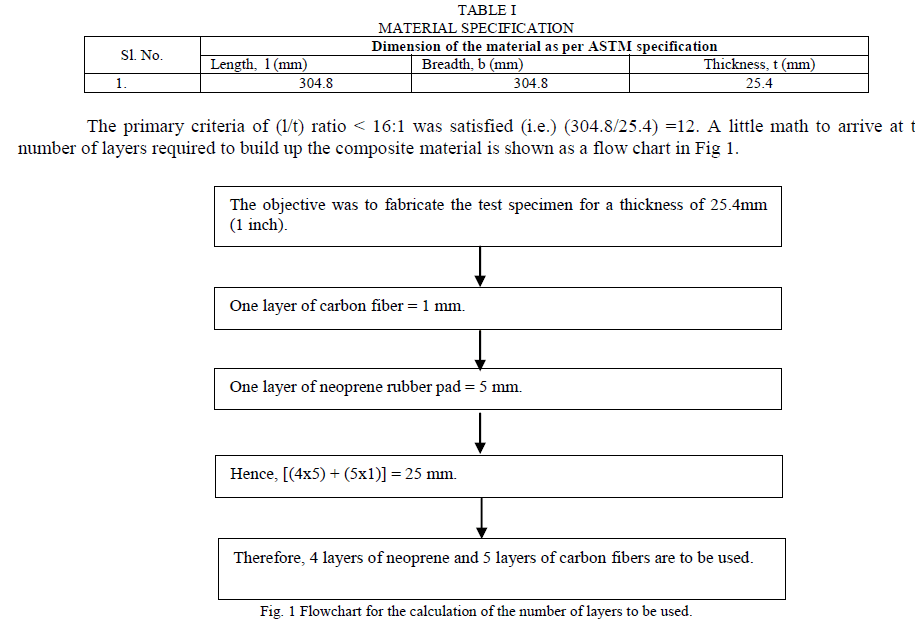 |
| B. Orientation of Layers The orientation of layers can be made unidirectional or quasi-isotropic. The term quasi-isotropic means symmetry and balance of the layering technique which result in uniform properties in two directions. So a combination of layers with different orientation was tried out in ANSYS and the best combination with quasi-isotropic property is selected. Modeling of the carbon fiber reinforced polymer (CFRP) in ANSYS to find out the first mode of vibration is shown in Fig 2. The Fig. 2 shows a quasi-isotropic orientation of the carbon fibers (material #1) and rubber (material #2). Naming the longitudinal direction of the surface layer the 0o ply, this structure is referred as 90o-0o-45o-0o-90o-0o- 45o-90o. The different possible orientation of layers is designed using permutation and combination and the fundamental frequency of vibration was calculated in each case. The design with the highest first mode of frequency is then selected for further tests. |
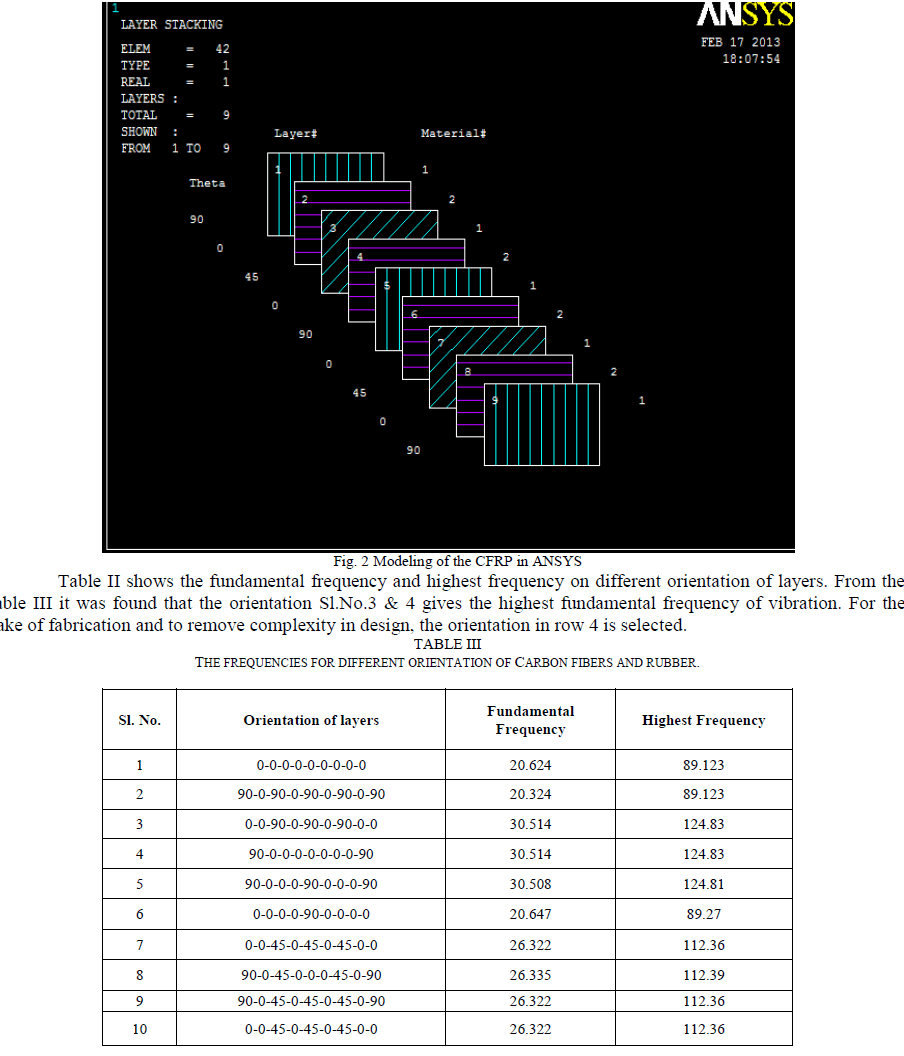 |
| C. Fabrication of the specimen The Orientation of layers which gives the highest fundamental frequency was selected for fabrication. The orientation 90o-0o-0o-0o-0o-0o-0o-0o-90o was chosen to remove complexity in design. The pictorial representation of the steps involved in fabrication is depicted clearly in the Fig. 3. A mould was designed to accommodate the rubber pad and carbon fibers which were cut as per dimensions (a) & (b). The rubber pad was scratched and carbon fibers were oriented according to specifications (c) & (d). The carbon fibers were coated with epoxy resin and made to dry in the hot sun (e) & (f). |
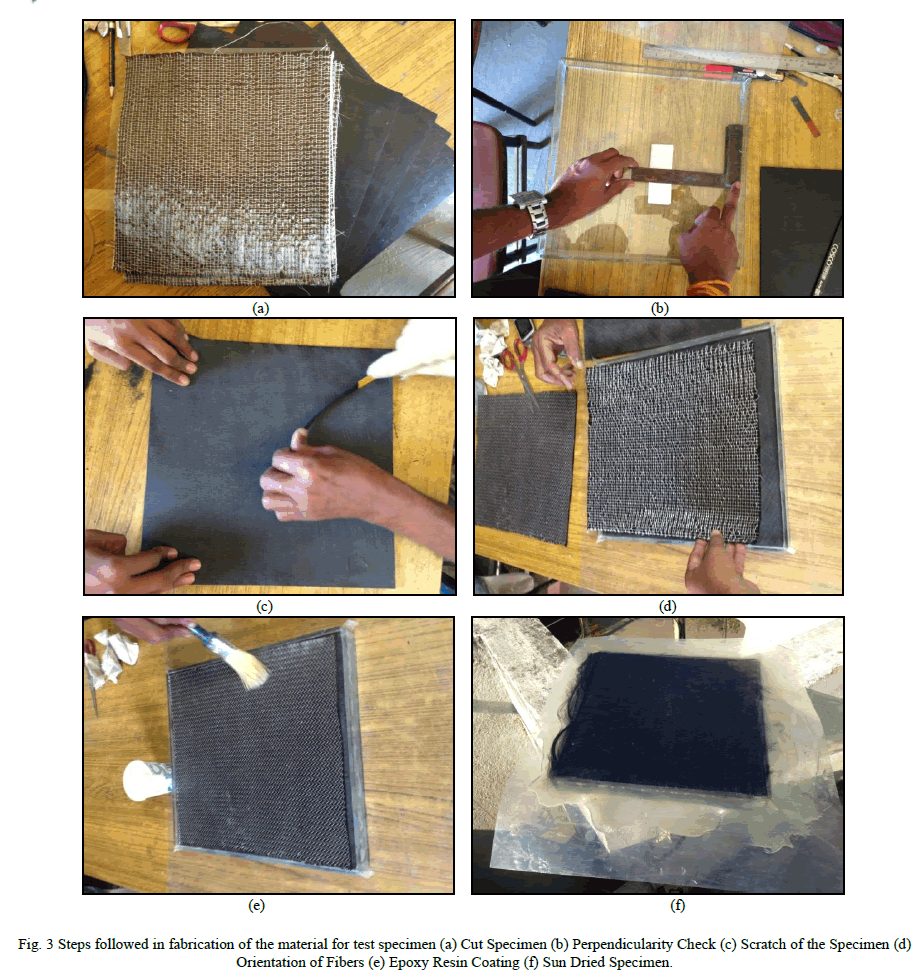 |
IV. EXPERIMENTAL INVESTIGATIONS AND FINDINGS |
| Experimental investigation was conducted on the specimen to determine the mechanical properties namely, tensile strength, compressive strength, flexural strength and impact strength. A.Tension Test A tensile test was conducted on the flat test specimen which was cut as per ASTM specification (ASTM D 638).The dimensions of the specimen was thickness 25.00 mm, width 13.60 mm and Area 340.00 mm2. The stress strain plot of the test specimen under tension is shown in Fig. 4. From the graph (Fig. 4), it was observed that the material has undergone maximum extension in its length and it seemed to possess enough toughness. The stress gradually increased with the application of force, yielded and attained the ultimate stress of 32.5 N/mm2 and eventually it has collapsed at a stress value of about 4 N/mm2. |
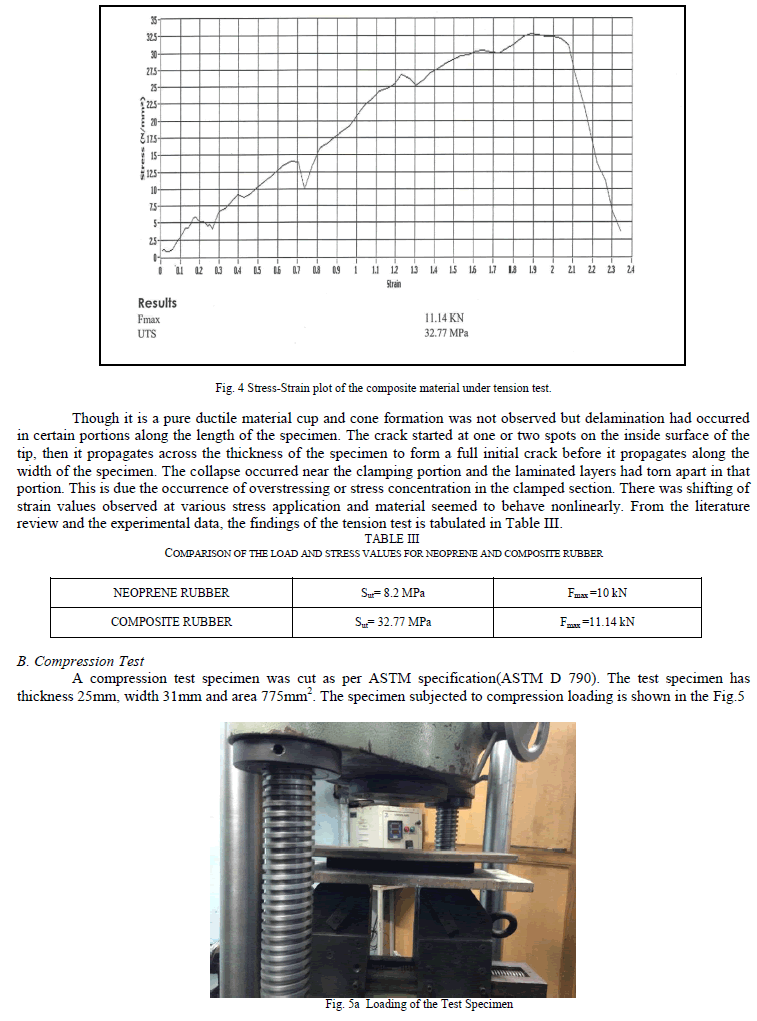 |
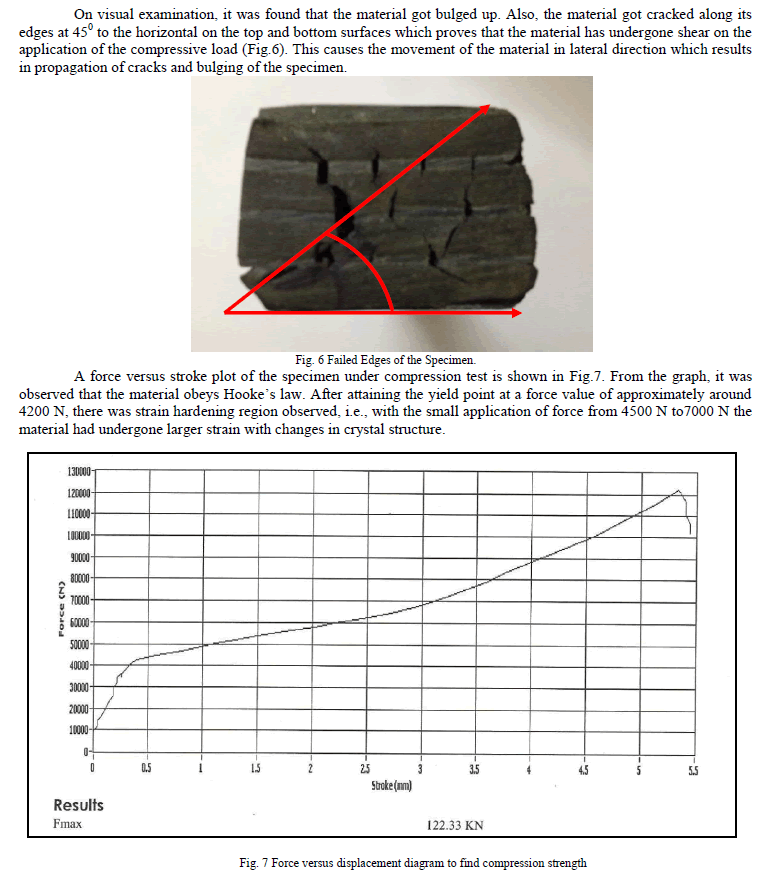 |
| C.Flexure Test The test specimen for three point bending was cut as per ASTM specification (ASTM D 256) with the following dimensions, thickness 25.5 mm and width 29.4 mm. The loading of the specimen under bending and final failure due to delamination is pictorially depicted in Fig. 8. From Fig. 9, it is found that the force versus displacement curve is a sloping straight line upto the maximum load 1630N. The curve increases linearly upto a deflection value of 30mm after which there is a fluctuation in both load and deflection values. The above observation gives rise to an inference that the material can withstand a deflection of 30mm under the maximum loading condition. When bending of material initiated, the epoxy resin layers got weakened, which resulted in delamination of the specimen layers. Since the top fibers underwent compression and bottom fibers experienced elongation, fine cracks appeared at the bottom edges and propogated in a direction perpendicular to the specimen. |
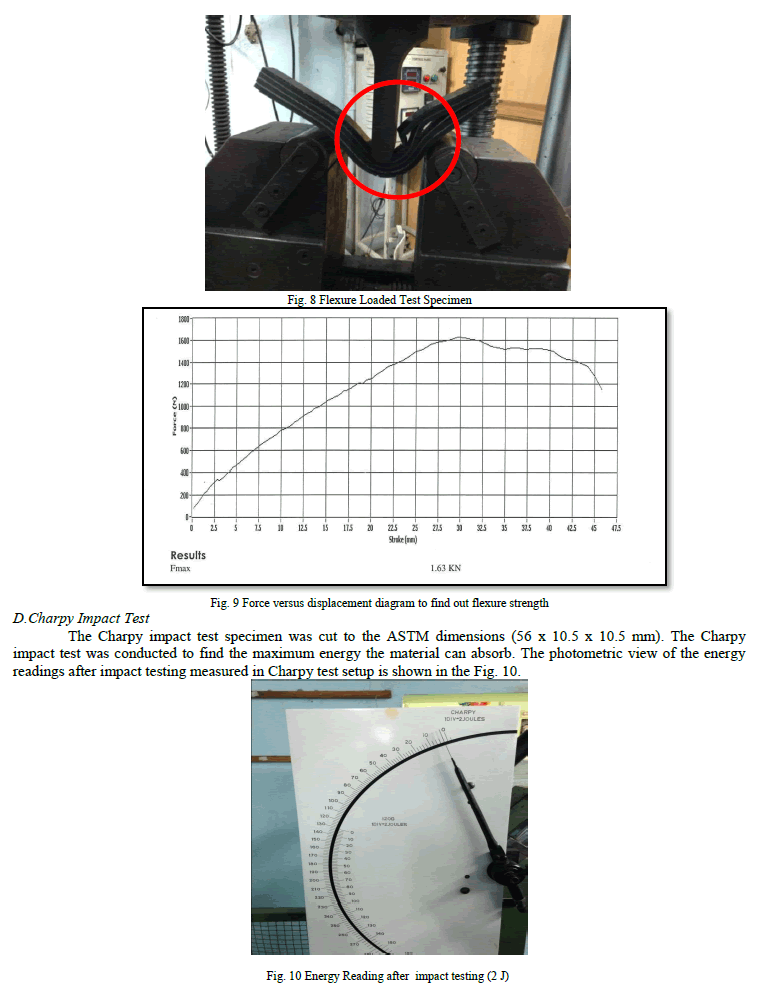 |
| The absorbed energy is calculated by taking the average of three readings. Here, the energy absorbed is 300- 2=298 J in all three cases.Impact Energy absorbed = (298+298+298)/3= 298 J. |
V. RESULTS AND COMPARISONS |
| The values obtained as a result of design modification and subsequent mechanical testing are as follows: Design Modification The fundamental frequency of vibration of the chosen material was found to have improved from 1.77 Hz to 30.5 Hz after reinforcing with carbon fibers.The fundamental frequency has gone up nearly 17 times. Tension Test The tension test under a Universal Testing Machine (UTM) gave rise to a larger value of ultimate strength of 32.77 MPa. The Ultimate strength of the test specimen was nearly four times the original value which suggests that the material could withstand tension in addition to compression. Compression Test The Compression test of the specimen was found to be 12.93 MPa. The specimen was able to withstand a maximum compressive load of 122.33 kN. Flexure Test The 3-point bending or flexure test yielded a bending strength value of 19.18 MPa. The maximum deflection that the specimen underwent for a maximum bending load of 1630N was 30 mm. Impact Test The Charpy test revealed that the test specimen was able to absorb as much as 298 J of the available energy on a scale of 300 J. |
VI. CONCLUSION |
| The Dynamic analysis indicated that the fundamental frequency of vibration of the chosen material had improved after reinforcing with carbon fibers. The orientation of the carbon fibers had also influenced the mode shapes. The fabrication of the material done at the ambient temperature has not affected the mechanical properties in anyway. The testing of material in Universal tension testing machine revealed that the material behaviour is superior in tension, compression and bending than the elastomeric rubber. The compression test revealed that the specimen is as strong in compression as in tension. The flexure test showed that the specimen bends elastically upto the maximum load value after which the formation of cracks started on the outer edges. The crack propagation in the lateral direction lead to delamination and final failure of the material. The impact test suggested that the material was able to absorb nearly 99.33% of the kinetic energy due to the impact. Though it is a bit expensive, these superior mechanical properties makes it a viable replacement as a energy absorber. In addition to synthetic carbon fibers, natural fibers from coconut and banyan trees can also be used as a supplement to bring down the cost of the final product. |
References |
|